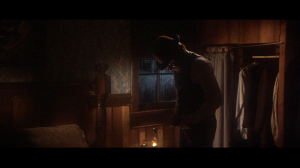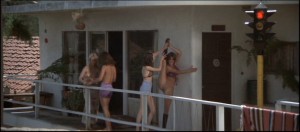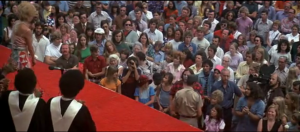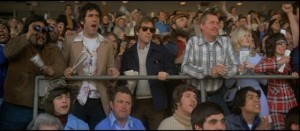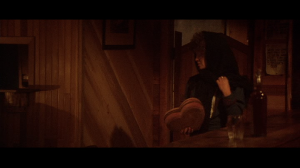The following is from the [London] National Film Theatre’s program guide in December-January 1975-76, introducing a retrospective that I curated. If the valuation that I placed on Altman seems more idealized to me now than it did at the time, the fact that it came shortly after his best run as a filmmaker explains much of my enthusiasm. But my disillusionment with the media support of Altman already began to sour after I described at length the use of sound in a particular sequence from California Split to a BBC-Radio interview, only to discover that the broadcast version blithely substituted a different sequence from the film to illustrate my point, thereby reducing my analysis to gibberish. -– J.R.
While most commercial American streamliners turn all members of an audience into second-class passengers following the same route from an identical vantage point, Robert Altman’s multilinear adventures oblige us to take some initiative in charting out the trip -– supplying one’s own connections, and pursuing one’s own threads and interpretations in order to participate in a game where everyone, on-screen and off, is entitled to a different piece of the action.
Admittedly, this is a somewhat idealized description of an approach that is still in a state of development, and not every Altman film conforms precisely to this model. From Countdown to Nashville — and quite apart from his varied earlier work in TV and elsewhere, which this season omits – he has followed a jagged path of trial and error. But over the six years traversed in this retrospective, he had gradually been evolving a set of methods that continue to grow in overall range and confidence.
Altman creates the space for our participation in a number of ways: Through a use of overlapping verbiage, which makes each spectator into a selective eavesdropper . Through the unpredictable interplay brought about through the intervention of an independent ‘text’ –- from the p.a. announcements in M*A*S*H to the children’s book excerpts in Images, from the radio shows in Thieves Like Us to the political campaign speeches in Nashville -– which requires the activity of a personal synthesis. Through the off-center timing, spacing and framing os scenes which require one to pick and choose one’s own stresses and points of entry, treating the entire screen as a surface to scan rather than as a set of fixed hierarchical values to follow. More specifically, through a use of the zoom lens as functional and justifiable as that of any narrative director since Rossellini, whereby the camera by becoming a creative witness, encourages the viewer to make independent choices of attention in concert with or in opposition to this active guide. And through an increasing use of actors as free and autonomous agents, individually and collectively generating their own meanings and interest beyond the dictates of a script or thesis, coupled with a use of improvisation that inspires an accompanying spontaneity of response.
All these procedures potentially place filmmakers and viewers alike in a perpetual state of becoming, where form functions as a verb instead of a noun, a kind of work-in-progress that registers as a spirited form of play -– until or unless messages originating outside this process intervene to cut the creative participation short, as in the last scenes of The Long Goodbye and Nashville. These two movies, along with McCabe and Mrs. Miller and California Split, comprise Altman’s broadest steps to date towards an audience’s freedom; the others sustain interest as relevant forays along the way. Obviously, it is a freedom that can only grow in proportion to the capacities of audiences and filmmakers to recognize that it exists. -– Jonathan Rosenbaum

